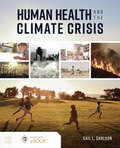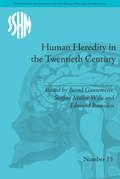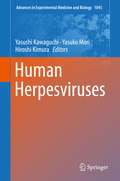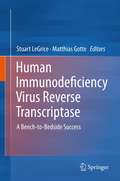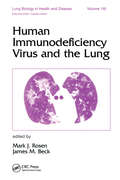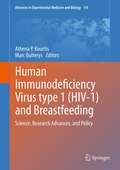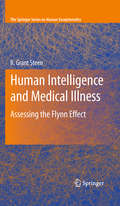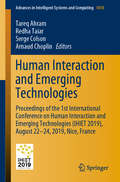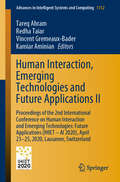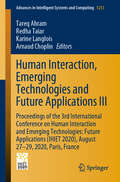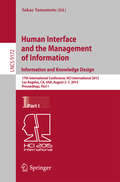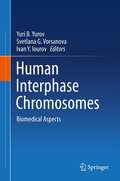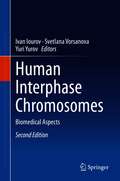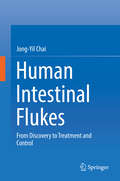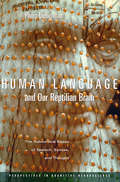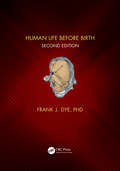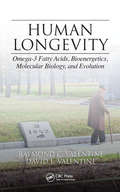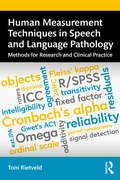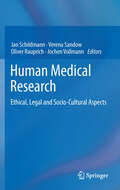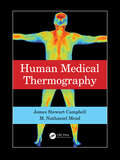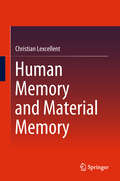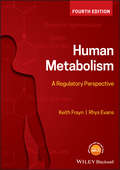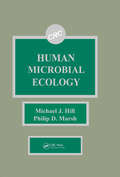- Table View
- List View
Human Health and the Climate Crisis
by Gail CarlsonHuman Health and the Climate Crisis offers a detailed exploration of the human health aspects of climate change, examining both the direct and indirect human health impacts of climate change while uniquely exploring climate justice -- the equitable protection of all people from climate impacts and the participation of all people in climate-related decision-making regardless of race/ethnicity, class, national origin, indigenous status and gender. This comprehensive, yet accessible text balances appropriate technical content with sufficient contextual information about public health, epidemiology, and climate modeling for students to be able to comprehend the scientific literature on health impacts.
Human Heredity in the Twentieth Century (Studies for the Society for the Social History of Medicine #15)
by Bernd GausemeierThe essays in this collection examine how human heredity was understood between the end of the First World War and the early 1970s. The contributors explore the interaction of science, medicine and society in determining how heredity was viewed across the world during the politically turbulent years of the twentieth century.
Human Herpesviruses (Advances in Experimental Medicine and Biology #1045)
by Hiroshi Kimura Yasushi Kawaguchi Yasuko MoriThis book introduces and reviews several topics for each human herpesvirus. One of the most important features of the book is that it covers aspects of both basic research and clinical medicine. Herpesviridae, a family of double-strand DNA viruses, has unique biological features by which these viruses establish latency after primary infection and reactivate in later life. Nine human herpesviruses are known so far, and each of them causes a variety of diseases in both primary infection and reactivation. Since the discovery of each human herpesvirus, an abundance of findings related to them has accumulated in basic research and clinical medicine. However, the vast majority of biological features is still masked in mystery. Furthermore, a strategy of treatment and prevention has not yet been established for most human herpesviruses. A wide range of readers will be interested in this volume with its treatment of problematic points and latest findings in the field.
Human Immunodeficiency Virus Reverse Transcriptase
by Matthias Gotte Stuart LegriceThe Reverse Transcriptase (RT) of Human Immunodeficiency Virus Type 1 (HIV-1) arguably ranks amongst one of the most extensively studied retroviral enzymes. Heterologous expression and purification of HIV-1 RT in the early eighties, approval of the first nucleoside analogue RT inhibitor (NRTI) in 1987, discovery of resistance to RT inhibitors, approval of the first non-nucleoside analogue RT inhibitor (NNRTI) in 1996 and the various crystal structures of RT with and without bound substrate(s) and/or inhibitors represent only a few of the important milestones that describe the a bench-to-bedside success in the continuing effort to combat HIV-1 infection and its consequences. Nucleoside and nonnucleoside RT inhibitors remain important components in frequently used drug regimens to treat the infection. RT inhibitors also play important roles in recently validated strategies to prevent transmission of the virus. The relevance of HIV-1 RT as a drug target has simultaneously triggered interest in basic research studies aimed at providing a more detailed understanding of interactions between proteins, nucleic acids, and small molecule ligands in general terms. In light of the ever-growing knowledge on structure and function of HIV-1 RT, this enzyme serves as a valuable "model system" in efforts to develop novel experimental tools and to explain biochemical processes. This monograph is designed to provide an overview of important aspects in past and current HIV-1 RT research, with focus on mechanistic aspects and translation of knowledge into drug discovery and development. The first section includes chapters with emphasis placed on the coordination of the RT-associated DNA polymerase and ribonuclease H (RNase H) activities. The second covers mechanisms of action and future perspectives associated with NRTIs and NNRTIs, while the third section includes chapters focusing on novel strategies to target the RT enzyme. Chapters of the final part are intended to discuss mechanisms involved in HIV variability and the development of drug resistance. We hope that these contributions will stimulate interest, and encourage research aimed at the development of novel RT inhibitors. The lack of bona fide RNase H inhibitors with potent antiviral activity provides an example for challenges and opportunities in the field.
Human Immunodeficiency Virus and the Lung (Lung Biology in Health and Disease)
by Mark J. Rosen James M. BeckSynthesizing disparate information into a readily accessible format, this insightful volume presents state-of-the-art reviews on the basic and clinical features of pulmonary diseases in HIV-infected individuals-informing critical decision making as well as suggesting avenues for future research. A beneficial compendium for those dealing with pulmonary complications of HIV infection, Human Immunodeficiency Virus and the Lungsurveys current knowledge on the epidemiology of HIV infection examines HIV's effects on lung cells in addition to immune functions within the lung details individual pulmonary infections in terms of etiology, clinical presentation, diagnosis, treatment, and prophylaxis emphasizes the indications and limitations of various diagnostic techniques, including invasive and noninvasive testing and screening considers noninfectious pulmonary complications from neoplastic and inflammatory to immunological disorders advises on the management of individuals in intensive care with the aid of morbidity and mortality data assesses common recommendations as well as provides clear guidelines for preventing the transmission of infectious pathogens and more!
Human Immunodeficiency Virus type 1 (HIV-1) and Breastfeeding
by Marc Bulterys Athena P. KourtisThe HIV pandemic continues to levy a heavy burden on the human race world-wide. The estimated number of people who became newly infected with HIV in 2009 was 2.6 million; most of these individuals live in Sub-Saharan Africa, followed by India and Southeast Asia. An estimated 370,000 new cases of pediatric infections occurred globally in 2009 (or more than 1,000 new infections every day), practically all of them through mother-to-child transmission. Up to 40% of all new infant HIV infections occur during breastfeeding. While breastfeeding by HIV-infected mothers is not recommended in the U.S. and other resource-rich settings where safe replacement feeding is easily available, the situation is different in many resource-limited settings, where replacement feeding is not safe or available and carries a high risk of infections (diarrhea, pneumonia) and infant malnutrition. Mothers in such settings are faced with a difficult dilemma: to breastfeed their infants in order to provide their infants with its many benefits (nutritional, immunologic, cognitive), but to also risk transmitting HIV. These challenges have prompted an intensive search for new prophylactic and therapeutic strategies in order to prevent infants from acquiring HIV infection through breastfeeding. In this book, expert HIV researchers critically review every aspect of this highly evolving and topical subject. The opening chapters deal with the epidemiology, global magnitude and biologic mechanisms of HIV-1 transmission from mother to child through breastfeeding and include considerations of the virus (quantity, compartments, characteristics) and the host (genetic, immunity-innate, cellular, humoral). The effects of breastfeeding on the HIV-infected mother's health and nutritional status, and the social and cultural issues associated with the practice of breastfeeding are also discussed. The next few chapters provide cutting-edge reviews of the latest approaches to prevention of HIV transmission to the infant through breastfeeding, including antiretroviral strategies, nutritional and immune-based approaches, and treatment of expressed breast milk. The remaining chapters provide a fascinating review of the many iterations this subject has received, as reflected in the several different sets of guidelines for infant feeding by HIV-infected mothers issued by the World Health Organization, and a debate by leading scientists on whether HIV-infected mothers should breastfeed their infants-in resource-limited and in resource-rich settings. A comprehensive overview of the current state of implementing the new evidence for prevention of breastfeeding transmission of HIV all over the world is also presented. Essential reading for the many disciplines of scientists and clinicians working on HIV/AIDS and other retroviruses, pediatricians, obstetricians/gynecologists, as well as all health-care professionals interested in expanding their understanding on the subject.
Human Intelligence and Medical Illness
by R. Grant SteenThere's little doubt that people are growing smarter. This effect is so strong that IQ tests must be renormed periodically to prevent classifying an overabundance of people as geniuses. The question is why is this collective rise in IQ - known as the Flynn effect -occurring? Possible theories to explain the Flynn effect have ranged from better parenting to faster evolution. Bringing a bold new voice to the debate, Human Intelligence and Medical Illness sets out a simple definition of intelligence that is appropriate for assessing intelligence at the population level. The definition is then used to probe the relationship between population intelligence and public health. This volume uses the latest medical and behavioral science research to argue that declines in serious disease and illness-causing conditions (e.g., lead paint in buildings) correlate strongly with continued cognitive gains in both developed and developing countries. Current political realities explain why the Flynn effect should be approached as a public policy as well as a public health issue. This provocative volume: Reviews the most widely held hypotheses accounting for the Flynn effect. Examines the relationship between intelligence and public health. Assesses the extent to which public health improvements can potentially account for the Flynn effect. Details how treatment of common medical problems may result in a substantial rise in IQ. Explores the possibility of continued IQ gains in the United States and worldwide. Reframes the Flynn effect in the contexts of public health, early childhood education, and social justice. With its groundbreaking findings on the causes of cognitive impairment and the possibility of cognitive improvement, Human Intelligence and Medical Illness is must-reading for researchers, professors, and graduate students in developmental psychology, education, public health, psychiatry, neuroscience, social work, and related fields.
Human Interaction and Emerging Technologies: Proceedings of the 1st International Conference on Human Interaction and Emerging Technologies (IHIET 2019), August 22-24, 2019, Nice, France (Advances in Intelligent Systems and Computing #1018)
by Tareq Ahram Redha Taiar Serge Colson Arnaud ChoplinThis book reports on research and developments in human-technology interaction. A special emphasis is given to human-computer interaction, and its implementation for a wide range of purposes such as healthcare, aerospace, telecommunication, and education, among others. The human aspects are analyzed in detail. Timely studies on human-centered design, wearable technologies, social and affective computing, augmented, virtual and mixed reality simulation, human rehabilitation and biomechanics represent the core of the book. Emerging technology applications in business, security, and infrastructure are also critically examined, thus offering a timely, scientifically-grounded, but also professionally-oriented snapshot of the current state of the field. The book is based on contributions presented at the 1st International Conference on Human Interaction and Emerging Technologies, IHIET 2019, held on August 22-24, in Nice, France. It offers a timely survey and a practice-oriented reference guide to systems engineers, psychologists, sport scientists, physical therapists, as well as decision-makers, designing or dealing with the new generation of service systems.User Experience of a Social Media Based Knowledge Sharing System in Industry Work, Chapter of this book is available open access under a CC BY 4.0 license at link.springer.com
Human Interaction, Emerging Technologies and Future Applications II: Proceedings of the 2nd International Conference on Human Interaction and Emerging Technologies: Future Applications (IHIET – AI 2020), April 23-25, 2020, Lausanne, Switzerland (Advances in Intelligent Systems and Computing #1152)
by Tareq Ahram Redha Taiar Vincent Gremeaux-Bader Kamiar AminianThis book reports on research and developments in human-technology interaction. A special emphasis is given to human-computer interaction, and its implementation for a wide range of purposes such as healthcare, aerospace, telecommunication, and education, among others. The human aspects are analyzed in detail. Timely studies on human-centered design, wearable technologies, social and affective computing, augmented, virtual and mixed reality simulation, human rehabilitation and biomechanics represent the core of the book. Emerging technology applications in business, security, and infrastructure are also critically examined, thus offering a timely, scientifically-grounded, but also professionally-oriented snapshot of the current state of the field. The book is based on contributions presented at the 2nd International Conference on Human Interaction and Emerging Technologies: Future Applications, IHIET-AI 2020, held on April 23-25, in Lausanne, Switzerland. It offers a timely survey and a practice-oriented reference guide to researchers and professionals dealing with design and/or management of the new generation of service systems.
Human Interaction, Emerging Technologies and Future Applications III: Proceedings of the 3rd International Conference on Human Interaction and Emerging Technologies: Future Applications (IHIET 2020), August 27-29, 2020, Paris, France (Advances in Intelligent Systems and Computing #1253)
by Tareq Ahram Redha Taiar Arnaud Choplin Karine LangloisThis book reports on research and developments in human-technology interaction. A special emphasis is given to human-computer interaction, and its implementation for a wide range of purposes such as healthcare, aerospace, telecommunication, and education, among others. The human aspects are analyzed in detail. Timely studies on human-centered design, wearable technologies, social and affective computing, augmented, virtual and mixed reality simulation, human rehabilitation and biomechanics represent the core of the book. Emerging technology applications in business, security, and infrastructure are also critically examined, thus offering a timely, scientifically-grounded, but also professionally-oriented snapshot of the current state of the field. The book is based on contributions presented at the 3rd International Conference on Human Interaction and Emerging Technologies: Future Applications, IHIET 2020, held on August 27-29, 2020. It offers a timely survey and a practice-oriented reference guide to researchers and professionals dealing with design and/or management of the new generation of service systems.
Human Interface and the Management of Information. Information and Knowledge Design
by Sakae YamamotoThe two-volume set LNCS 9172 and 9173 constitutes the refereed proceedings of the Human Interface and the Management of Information thematic track, held as part of the 17th International Conference on Human-Computer Interaction, HCII 2015, held in Los Angeles, CA, USA, in August 2015, jointly with 15 other thematically similar conferences. The total of 1462 papers and 246 posters presented at the HCII 2015 conferences were carefully reviewed and selected from 4843 submissions. These papers address the latest research and development efforts and highlight the human aspects of design and use of computing systems. The papers accepted for presentation thoroughly cover the entire field of human-computer interaction, addressing major advances in knowledge and effective use of computers in a variety of application areas. This volume contains papers addressing the following major topics: information visualization; information presentation; knowledge management; haptic, tactile and multimodal interaction; service design and management; user studies.
Human Interphase Chromosomes
by Svetlana G. Vorsanova Ivan Y. Iourov Yuri B. YurovThis title will focus on the study of human interphase chromosomes and its relation to health and disease. Orchestrated organization and human genome function in interphase nuclei at the chromosomal level have been repeatedly shown to play a significant role in a variety of basic biological processes involved in realization and inheritance of genetic information within and between species. Current biomedical sciences of post-genomic era refocus basic and applied studies of interphase nuclei genetics and genomics with special attention to interphase chromosome behavior in health and disease. Additionally, related processes are a target of studies elucidating the role of interphase chromosome behavior during development, chromosome/DNA replication, DNA reparation etc. Studies of interphase nuclei have an appreciable impact on different areas of biomedical sciences such as cell biology, neurobiology, cancer research, developmental biology, epigenetics, cytogenetics, and medical genetics, as a whole. Moreover, development of innovative and emergent technologies to analyze interphase nuclei are closely associated with application of these techniques in clinical, diagnostic and research practice to solve reproductive problems (including infertility and spontaneous abortions), to investigate congenital malformations (including those produced by aneuploidy and other chromosome abnormalities); genetic diseases (including cardiac, immune, neurological and psychiatric diseases), and cancer. This title will serve as a source of new valuable information and promising ideas for a wide audience of professionals in biomedicine including researchers, scientists, and healthcare professionals in human genetics, cytogenetics, and developmental biology.
Human Interphase Chromosomes: Biomedical Aspects
by Ivan Iourov Svetlana Vorsanova Yuri YurovThis second edition focuses on the study of human interphase chromosomes and its relation to health and disease. Orchestrated organization and behavior of the human genome in interphase nuclei at chromosomal level has been repeatedly shown to play a significant role in almost all basic biological processes involved in the processing and inheritance of genetic information within and between species. Accordingly, post-genomic bioscience appeals to basic and applied studies of interphase nuclei genetics and genomics with special attention to interphase chromosome behavior in health and disease. Additionally, elucidating the role of interphase chromosome behavior during development, chromosome/DNA replication, DNA reparation opens new horizons for basic and applied bioscience Studies of interphase nuclei have an appreciable impact on different areas of biomedical sciences such as cell biology, neurobiology, cancer research, developmental biology, epigenetics, cytogenetics, and medical genetics, as a whole. Moreover, development of innovative and emergent technologies to analyze interphase nuclei are closely associated with application of these techniques in diagnostic and research practices to solve reproductive problems (including infertility and spontaneous abortions), to investigate congenital malformations (including those produced by aneuploidy and other chromosome abnormalities); genetic diseases (including cardiac, immune, neurological and psychiatric diseases), and cancer. This second edition serves as a source of updated valuable information and promising ideas for a wide audience of professionals in biomedicine including researchers, scientists, and healthcare professionals in human genetics, cytogenetics, and developmental biology.
Human Intestinal Flukes: From Discovery to Treatment and Control
by Jong-Yil ChaiThis book provides up-to-date information on the characteristics of each species of intestinal fluke found in humans and on the management of infections caused by these trematodes. Biology, epidemiology, host-parasite relationships, pathogenicity, clinical aspects, diagnosis, and treatment are all reviewed in detail. The zoonotic intestinal flukes comprise 38 genera belonging to 16 families. They are morphologically diverse and each species has a characteristic life cycle and geographical distribution. Intestinal fluke infections are commonly considered as tropical endemic diseases in Asian countries, where 6 million people are infected, but the geographical limits and populations at risk are expanding and changing owing to a range of factors, including growing international markets, improved transportation systems, changes in eating habits, demographic trends, and climate change. While the pathogenicity of intestinal flukes is generally mild, the impact in immunocompromised individuals requires clarification and some diagnostic problems remain to be solved. In exploring all aspects of human intestinal fluke infections, this book will be invaluable for clinicians and researchers alike.
Human Language and Our Reptilian Brain: The Subcortical Bases of Speech, Syntax, and Thought (Perspectives in Cognitive Neuroscience)
by Philip LiebermanThis book is an entry into the fierce current debate among psycholinguists, neuroscientists, and evolutionary theorists about the nature and origins of human language. A prominent neuroscientist here takes up the Darwinian case, using data seldom considered by psycholinguists and neurolinguists to argue that human language--though more sophisticated than all other forms of animal communication--is not a qualitatively different ability from all forms of animal communication, does not require a quantum evolutionary leap to explain it, and is not unified in a single "language instinct." Using clinical evidence from speech-impaired patients, functional neuroimaging, and evolutionary biology to make his case, Philip Lieberman contends that human language is not a single separate module but a functional neurological system made up of many separate abilities. Language remains as it began, Lieberman argues: a device for coping with the world. But in a blow to human narcissism, he makes the case that this most remarkable human ability is a by-product of our remote reptilian ancestors' abilities to dodge hazards, seize opportunities, and live to see another day.
Human Life Before Birth, Second Edition
by Frank DyeThis textbook presents essential and accessible information about human embryology including practical information on human health issues and recent advances in human reproductive technology. Starting with biological basics of cell anatomy and fertilization, the author moves through the development of specific organs and systems, before addressing social issues associated with embryology. Each chapter includes specific objectives, general background, study questions, and questions to inspire critical thinking. Human Life Before Birth also contains two appendices and a full glossary of terms covered in the text. Clinicians and researchers in this field will find this volume indispensable. Key selling features: Explores all the developmental and embryological events that occur in human emryonic and fetal life Reviews basic cell biology, genetics, and reproduction focusing entirely on humans Summarizes the development of various anatomical systems Examines common birth defects and sexually transmitted diseases including emerging concerns such as Zika Documents assisted fertilization technologies and various cultural aspects of reproduction
Human Longevity: Omega-3 Fatty Acids, Bioenergetics, Molecular Biology, and Evolution
by Raymond C. Valentine David L. ValentineMore than 7 billion people inhabit the earth and all of them are subject to aging. This book is aimed at persons interested in a molecular explanation of how our cells age. Human Longevity: Omega-3 Fatty Acids, Bioenergetics, Molecular Biology, and Evolution is built on the proposition that we age as our mitochondria age. It suggests a revised vers
Human Measurement Techniques in Speech and Language Pathology: Methods for Research and Clinical Practice
by Rietveld ToniHuman Measurement Techniques in Speech and Language Pathology gives an overview of elicitation methods in the assessment and diagnosis of speech and language disorders and explains approaches to the qualification of the obtained data in terms of agreement and reliability. Despite technological advances in the assessment and diagnosis of speech and language disorders, the role of human judgements is as important as ever. Written to be accessible to students, researchers and practitioners alike, the book not only provides an overview of elicitation procedures of human judgement such as visual analog scaling, Likert scaling etc. but also presents methodological and statistical approaches to quality assessment of judgements. The book introduces statistical procedures for processing scores obtained in paired comparisons and in the context of signal detection theory, and introduces software relevant for the calculation of a large number of coefficients of reliability and agreement. Featuring a wealth of reader-friendly pedagogy throughout, including instructions for using SPSS and R software, clarified by many illustrations and tables, example reports, and exercise questions to test the readers understanding, it is an ideal companion for advanced students and researchers in the field of speech pathology.
Human Medical Research
by Verena Sandow Jan Schildmann Jochen Vollmann Oliver RauprichMedical research involving human subjects has contributed to considerable advancements in our knowledge, and to medical benefits. At the same time the development of new technologies as well as further globalisation of medical research raises questions that require the attention of researchers from a range of disciplines. This book gathers the contributions of researchers from nine different countries, who analyse recent developments in medical research from ethical, historical, legal and socio-cultural perspectives. In addition to reflections on innovations in science such as genetic databases and the concept of "targeted therapy" the book also includes analyses regarding the ethico-legal regulation of new technologies such as human tissue banking or the handling of genetic information potentially relevant for participants in medical research. Country and culture-specific aspects that are relevant to human medical research from a global perspective also play a part. The value of multi- and interdisciplinary analysis that includes the perspectives of scholars from normative and empirical disciplines is a shared premise of each contribution.
Human Medical Thermography
by James Stewart Campbell M. Nathaniel MeadWant to incorporate medical infrared imaging into your practice but can’t find a book that explains how to do it? Well, this book is for you! Complete, practical instructions are provided on imager choice and care as well as the physical needs of a thermography service from the imaging room layout to the computer requirements. How to acquire, interpret, and report a thermal examination is covered in detail. Fully illustrated with both normal and abnormal images, Human Medical Thermography provides practitioners of all types with the knowledge to design and operate a scientifically based thermography practice. Key Features• Shows how to select the best thermal imager for your clinical practice, care for it, and use it correctly.• Explains how to take medical quality thermal images and scale them for maximum visual effect using the guidelines detailed in this book.• Details myriad ways that thermography can aid in medical diagnosis and improve surgical outcomes.
Human Memory
by Gabriel A. RadvanskyHuman Memory, 4th edition, provides a comprehensive overview of research and theory on human memory. Written in an engaging style, the book is divided into three sections, providing an accessible introduction to the application and assessment of memory theory. Beginning with the history of memory, the first section explores basic methodology and neuroscience. The second section examines the key topics of memory such as the sensory registers, mechanisms of forgetting and short-term, nondeclarative, episodic, and semantic memory. The third section focuses on specialist topics such as amnesia, memory for space and time, autobiographical memory, memory and reality, memory and the law, metamemory and formal models of memory. Instructors could pick and chose which of these chapters best fit the goals of their course. New to this edition: More prominent discussion of neuroscience findings. Coverage of a wider range of neuroscientific techniques. Greater emphasis on memory changes over time. New explanation of how to calculate a wider range of signal detection measures. Additional content on a wide range of topics including the mirror effect, sleep-related memory processes, vicarious autobiographical memories, inter-generational memory transmission, the impact of lying on memory, eyewitness collaboration, and aging and spatial memory. Expanded coverage of areas including theories of hypermnesia, chunking, serial order memory, prospective memory, threshold models, and eyewitness line-up identification. Updated companion resources, including PowerPoint slides and exam questions. The book highlights the application of memory theory and findings to everyday experience, presents in-depth explorations of studies, and provides opportunities for students to explore the assessment of memory in more laboratory-based settings. Packed full of student-friendly pedagogy including study questions, Stop and Review and Try it Out sections, Study in Depth text boxes, and more, Human Memory, 4th edition is an essential companion for all students of human memory.
Human Memory and Material Memory
by Christian LexcellentThis book investigates the fascinating concept of a continuum between human memory and memory of materials. The first part provides state-of-the-art information on shape memory alloys and outlines a brief history of memory from the ancient Greeks to the present day, describing phenomenological, philosophical, and technical approaches such as neuroscience. Then, using a wealth of anecdotes, data from academic literature, and original research, this short book discusses the concepts of post-memory, memristors and forgiveness, highlights the analogies between materials defects and memory traces in the human brain. Lastly, it tackles questions of how human memory and memory of materials work together and interact. With insights from materials mechanics, neuroscience and philosophy, it enables readers to understand and continue this open debate on human memory.
Human Memory: Second Edition
by Gabriel A. RadvanskyProvides students with a guide to human memory, its properties, theories about how it works, and how studying it can help us understand who we are and why we do the things that we do. For undergraduate and graduate courses in Human Memory. This book provides a very broad range of topics covering more territory than most books. In addition to some coverage of basic issues of human memory and cognition that are of interest to researchers in the field, the chapters also cover issues that will be relevant to students with a range of interests including those students interested in clinical, social, and developmental psychology, as well as those planning on going on to medical and law schools. The writing is aimed at talking directly to students (as opposed to talking down to them) in a clear and effective manner. Not too dense, but also not too conversational as well. This 2nd edition includes a series of exercises that allow the student to try out the concepts and principles conveyed in the chapters, or to use as the basis for exploring their own ideas.
Human Metabolism: A Regulatory Perspective (Frontiers In Metabolism/neurobiology Ser. #No. 1)
by Keith N. Frayn Rhys EvansThe updated bestselling guide to human metabolism and metabolic regulation The revised and comprehensively updated new edition of Human Metabolism (formerly Metabolic Regulation – A Human Perspective) offers a current and integrated review of metabolism and metabolic regulation. The authors explain difficult concepts in clear and concise terms in order to provide an accessible and essential guide to the topic. This comprehensive text covers a wide range of topics such as energy balance, body weight regulation, exercise, and how the body copes with extreme situations, and illustrates how metabolic regulation allows the human body to adapt to many different conditions. This fourth edition has been revised with a new full colour text design and helpful illustrations that illuminate the regulatory mechanisms by which all cells control the metabolic processes necessary for life. The text includes chapter summaries and additional explanatory text that help to clarify the information presented. In addition, the newly revised edition includes more content on metabolic pathways and metabolic diseases. This important resource: Is a valuable tool for scientists, practitioners and students across a broad range of health sciences including medicine, biochemistry, nutrition, dietetics, sports science and nursing Includes a full colour text filled with illustrations and additional diagrams to aid understanding Offers a companion website with additional learning and teaching resources. Written for students of medicine, biochemistry, nutrition, dietetics, sports science and nursing, Human Metabolism has been revised and updated to provide a comprehensive review of metabolism and metabolic regulation.
Human Microbial Ecology
by Michael J. Hill Philip D. MarshThe aim of this comprehensively written volume is to provide a baseline of information on the normal microflora at various sites in the body. It focuses on the mouth, upper digestive tract, large intestine, skin, and urinogenital tract. Written in an easy-to-read format, this book highlights the level of detail available. For example, it explains that in the mouth and colon the data are extremely detailed and good quantitative information is available on large numbers of bacterial species. This work analyzes the similarities and differences between the microfloras of the various "internal" surfaces, and discusses the clear value of good taxonomy. It focuses on problems and extended research in the progress at other sites. Because this work researches the advances and discoveries made in specific areas of human microbial ecology, it is an ideal source for all who are involved in microbiology, bacteriology, and infectious diseases.
